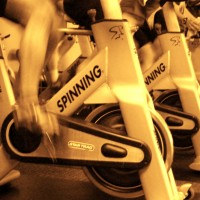You may have noticed how some people seem to bounce in the saddle on an indoor bike. But do you know why this happens and what you can do about it?
There are four quadrants to the pedal stroke, using the face of a clock as the guide:
- Over the top: 10:00–2:00
- Downstroke: 2:00–5:00
- Backstroke: 5:00–7:00
- Upstroke (recovery): 7:00–10:00
A novice rider usually has only one phase—straight down. He or she hasn’t perfected the sweeping back of the foot at the bottom or pushing the toe forward at the top. As a result, they push down furiously on the pedals and rely on the flywheel to take their foot around the rest of the way. When the right foot reaches the bottom of the crank arm, the leg can go no further, pushing the right hip off the saddle. The same happens on the left side. This continues over and over, at 90, 100, 110 times a minute per side (or whatever the upper limit is for that rider), creating the familiar bouncing.
That bouncing reverberates through the body of a novice rider, often causing the shoulders and head to bounce as well. This is what gives the “bobblehead” appearance.
Short-Term Solution


I have a few “older, ahem” riders in my class. I do some pedal drills earlier in the class, (pedaling circles, not squares) and tell them to remember these when moving into the faster cadences. If we go into a fast cadence, like 95 rpm’s I tell them if they can’t get there to aim for it, and see if they can get closer than last time, even for a few seconds.
A few months ago, after class a woman said to me very excitedly,”This was the first time I’ve hit 90 rpm’s!”. She was so excited. It took her over 6 months to get there, but she was so happy to achieve it. It also taught me that faster cadences are a skill that is learned and can take some time to develop.
I love learning from my “students”
Joe, that’s a great lesson your students have taught you! =)
It feels great when our students are excited about achieving something like that!
Your cues are great, asking them to just try to get closer, even just for a few seconds.
Cadence is a learnable skill, and for some, it may take longer to develop than others.
This is a GREAT article and will truly let me assist some of my chronic bouncers. These are folks who’ve been riding for a good amount of time, yet still struggle with faster cadences–now I have more information to share with them, which will hopefully help!